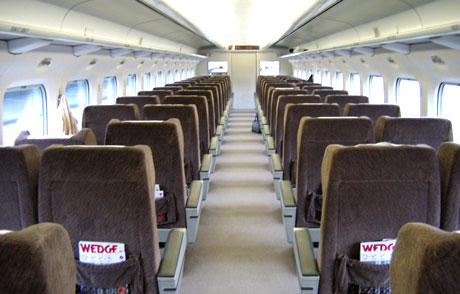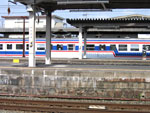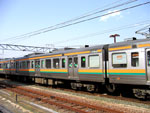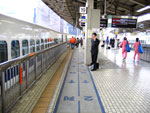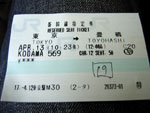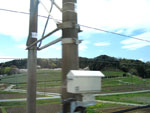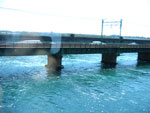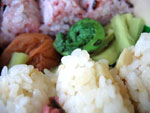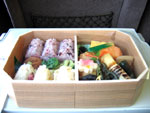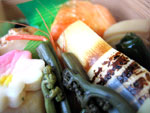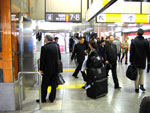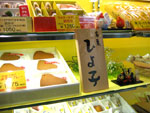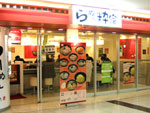Archive for the 'Trains' Category
Densha, Chikatetsu, and Shinkansen
「電車〠– Electric Train
「地下鉄〠– Subway
「新幹線〠– Bullet Train
I actually wanted to write about this before my post about Okazaki Castle. However, due to the incident that happened in Japan around the same time, I figure it’s a bit insensitive to do it back then. So I decided to wait even though chronologically, this happened first prior to my visit to Okazaki Castle or my arrival in Okazaki for that matter. Oh well, these things happen and besides, I use train from time to time so I don’t see how it’ll make that much of a difference whether or not I post this now or back then.
Anyway, when I first learned about ‘Densha’, ‘Chikatetsu’, and ‘Shinkansen’, I had a bit of difficulty understanding the difference between the three words. This is mostly because, in general, all three are basically trains that travel at high speed. It’s not until I arrive in Japan that I understand what the Japanese refers to as ‘Densha’ are basically all of the normal ground trains. These trains are mostly operated by JR (Japan Railways) although there are other companies that run similar service as well.
‘Chikatetsu’ are basically underground trains or subways, as some people called them. So far I’ve only encounter subways when I go to the big cities like Tokyo or Nagoya. To give you an example, if you want to go to Akihabara and you happen to own a JR rail pass, you’ll want to take the Yamanote line. However, if you stay at Asakusa like I did, you can’t take the Yamanote line straight away from Asakusa station. You first have to catch a subway from Asakusa to Ueno, then take the Yamanote line from the Ueno station.
Then there’s the ‘Shinkansen’. These are basically on-the-ground trains that travel at a speed that is faster than normal Densha. IIRC, these days Shinkansen runs at around 300km/h. Apparently the super-fast Nozomi runs even faster than that. The Shinkansen that I used was basically the one that services the Tokaido/Sanyo lines. This Shinkansen basically connects Tokyo, Nagoya, Kyoto and Osaka. Depending whether you take Hikari or Kodama, it’ll take approximately 3 hours to go from Tokyo to Osaka.
These trains travel so fast to the point that when another train passes by next to it, sometimes you can feel a slight shake inside the train. It took a while for me to get used to this and not have my heart jumped every couple of minutes. After a while, however, it was a pure joy to be inside a Shinkansen. If you happen to have a PSP+Ridge Racer game, try playing it inside a Shinkansen. I guarantee that you’ll get a kick out of it. It feels as if you really are driving a very fast car. The outside view is not that bad either, IMO.
Each Shinkansen is usually divided into smoking and non-smoking cabins. If you are a non-smoker like I am, then I suggest that you make a booking for a non-smoking cabin because you really don’t want to spend 3 hours in a cabin full of smokers. I once passed through it and I felt as if I’m smoking as well. In general, however, the Shinkansen is clean and tidy. So if you go to Japan, you probably want to try it once. And if you have the money to spare, you may want to pay for the more expensive Green cabin or even better, the super-fast Nozomi trains.
Inside the Shinkansen, you can also find some toilets, vending machines, and a mobile cafeteria that sells drinks, snacks, and bento boxes. The bento box is also another thing you should try while you’re taking Shinkansen. Each box is carefully prepared so that the food looks appetizing. Unfortunately, the bento boxes sold inside a Shinkansen do not contain hot foods so if you’re not into cold food like Sushi and Japanese pickled vegetables, this may not be your cup of tea. I enjoyed mine though it’s nice to try something different every day.
Anyway, because all trains travel at such a fast speed, it is rare that the train is late to arrive at the destination. However, this also means that you have to be on time for your train whether it’s Shinkansen, Densha, or Chikatetsu. If the train is supposed to leave at 9am in the morning, and you arrive at the station at 8.55am, then you have precisely 4 minutes and 59 seconds to board the train. That’s right, 4 minutes and 59 seconds, not 5 minutes, not 8 minutes, let alone 10 minutes. So if you’re late, you have no one to blame but yourself.
The major train stations themselves are pretty interesting to see. These stations normally have multiple entry and exit area and can be confusing for first time visitors. Some train stations have various shops that sells Omiyage (souvenir), Bento Boxes, and Clothes. There are also various restaurants if you go to the big one like the one in Ueno. I have to admit that I’m now somewhat converted to the wonder that is Ramen after trying a bowl of Ramen at a ramen shop inside Nagoya station.
Well, that went a lot longer than what I had in mind. There goes my plan to revise chapter 14-19. I better stop here but I’ll try to do another train/station entry if I manage to take some pictures when we go to Nagoya to watch the Dragons’ baseball game. I’ve heard that different province has different Omiyage on sale so I’d try to take pictures of the Omiyage in Nagoya. Anyway, if you have a specific pictures you want me to take, please let me know. I can’t guarantee that I’ll be able to take them but I’ll give it a try.
17 comments
